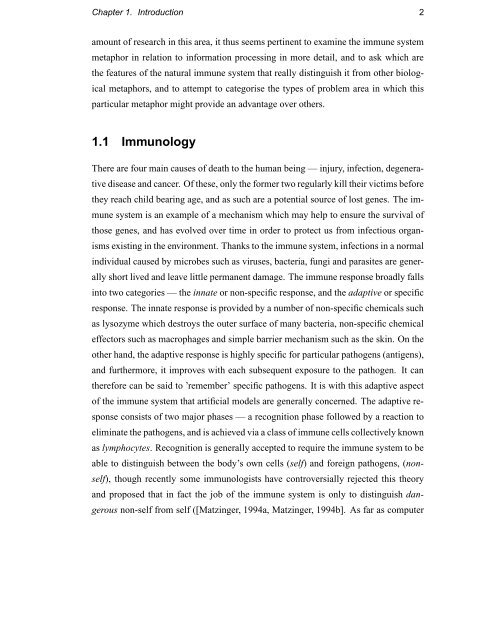Immunology as a Metaphor for Computational ... - Napier University
Immunology as a Metaphor for Computational ... - Napier University
Immunology as a Metaphor for Computational ... - Napier University
You also want an ePaper? Increase the reach of your titles
YUMPU automatically turns print PDFs into web optimized ePapers that Google loves.
Chapter 1. Introduction 2amount of research in this area, it thus seems pertinent to examine the immune systemmetaphor in relation to in<strong>for</strong>mation processing in more detail, and to <strong>as</strong>k which arethe features of the natural immune system that really distinguish it from other biologicalmetaphors, and to attempt to categorise the types of problem area in which thisparticular metaphor might provide an advantage over others.1.1 <strong>Immunology</strong>There are four main causes of death to the human being — injury, infection, degenerativedise<strong>as</strong>e and cancer. Of these, only the <strong>for</strong>mer two regularly kill their victims be<strong>for</strong>ethey reach child bearing age, and <strong>as</strong> such are a potential source of lost genes. The immunesystem is an example of a mechanism which may help to ensure the survival ofthose genes, and h<strong>as</strong> evolved over time in order to protect us from infectious organismsexisting in the environment. Thanks to the immune system, infections in a normalindividual caused by microbes such <strong>as</strong> viruses, bacteria, fungi and par<strong>as</strong>ites are generallyshort lived and leave little permanent damage. The immune response broadly fallsinto two categories — the innate or non-specific response, and the adaptive or specificresponse. The innate response is provided by a number of non-specific chemicals such<strong>as</strong> lysozyme which destroys the outer surface of many bacteria, non-specific chemicaleffectors such <strong>as</strong> macrophages and simple barrier mechanism such <strong>as</strong> the skin. On theother hand, the adaptive response is highly specific <strong>for</strong> particular pathogens (antigens),and furthermore, it improves with each subsequent exposure to the pathogen. It canthere<strong>for</strong>e can be said to ’remember’ specific pathogens. It is with this adaptive <strong>as</strong>pectof the immune system that artificial models are generally concerned. The adaptive responseconsists of two major ph<strong>as</strong>es — a recognition ph<strong>as</strong>e followed by a reaction toeliminate the pathogens, and is achieved via a cl<strong>as</strong>s of immune cells collectively known<strong>as</strong> lymphocytes. Recognition is generally accepted to require the immune system to beable to distinguish between the body’s own cells (self) and <strong>for</strong>eign pathogens, (nonself),though recently some immunologists have controversially rejected this theoryand proposed that in fact the job of the immune system is only to distinguish dangerousnon-self from self ([Matzinger, 1994a, Matzinger, 1994b]. As far <strong>as</strong> computer









![Unit 5. Switches and VLANs [PDF]](https://img.yumpu.com/34422504/1/184x260/unit-5-switches-and-vlans-pdf.jpg?quality=85)






